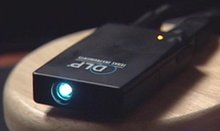“Pico” projector demo’d
Nov 13, 2008 — by LinuxDevices Staff — from the LinuxDevices Archive — 38 views Texas Instruments (TI) is demonstrating a tiny video projector that could prove small enough to embed in devices such as mobile phones. The 10-lumen “Pico” projector uses TI's DLP (digital light processing) technology, and is shown rendering a Linux desktop playing 24-bit RGB video at 60Hz.
Texas Instruments (TI) is demonstrating a tiny video projector that could prove small enough to embed in devices such as mobile phones. The 10-lumen “Pico” projector uses TI's DLP (digital light processing) technology, and is shown rendering a Linux desktop playing 24-bit RGB video at 60Hz.
(Click for larger view of TI's Pico Projector video)
TI's Pico projector measures a scant 2.8 x 1.6 x 0.6 inches (71 x 41 x 14mm). It accepts 5-V DC power, and uses a low-powered LED as its light source. It accepts a single mini-HDMI video input, and costs $350 as part of a Development Kit.


TI's Pico Projector, front and back
(Click either view to enlarge)
TI suggests mating the Pico Projector Development Kit with Digi-Key's $150 Beagle Board. When used with the Beagle board, an I2C signal can be used to control the projector through the HDMI connection, it says.

Pico projector diagram
A popular give-away at recent embedded trade shows, the Beagle board uses TI's TI OMAP3530 processor, and thus is among the first available boards based on ARM's Cortex-A8 processor core and superscalar ARMv7 architecture. The Beagle board comes with a special build of the Angstrom Linux distribution, however Canonical announced plans earlier today to port Ubuntu Desktop Linux to the ARMv7 architecture.

The Beagle Board
(Click for details)
In TI's video demo, Software Systems Engineer Jim Molina shows a desktop computing setup based on the Beagle board and the Pico projector. The demo shows what Molina reckons to be a “really good image” of 24-bit RGB video rendered at 60Hz, with a brightness output of just under 10 lumens. The video is projected onto a screen about the size of a typical LCD flat-panel display.



Output from TI's Pico projector video demo
(Click to enlarge)
The complete video is available as an exclusive download from LinuxDevices, here (Ogg Theora format — It's worth noting that the projector's output looked crisper in the video's original MP4 format, but we had to transcode it to save on monthly bandwidth charges!).
TI also offers a digital video software development kit for its OMAP3 processors.
This article was originally published on LinuxDevices.com and has been donated to the open source community by QuinStreet Inc. Please visit LinuxToday.com for up-to-date news and articles about Linux and open source.